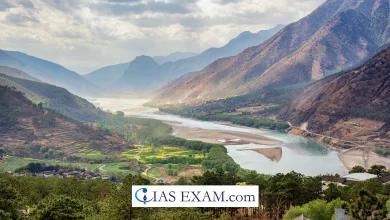
Context- A recent peer-reviewed study suggests that children, adolescents, and young adults’ cognitive function may be affected by low arsenic consumption.
What is Arsenic?
- Arsenic is a naturally occurring component of the earth’s crust that can be found abundantly in the air, water, and land.
- It is profoundly poisonous in its inorganic structure.
- It is normally present at undeniable levels in the groundwater of a few nations.
- Arsenic contamination of groundwater above the permissible level is thought to have the greatest impact on the states of West Bengal, Jharkhand, Bihar, Uttar Pradesh, Assam, Manipur, and Chhattisgarh in India.
Exposure
- Individuals are presented to raised degrees of inorganic arsenic through drinking defiled water, involving debased water in food arrangement and water system of food crops, modern cycles, eating polluted food, and smoking tobacco.
Health effects
- Arsenic poses the greatest threat to public health in contaminated water used for drinking, food preparation, and crop irrigation.
- Cancer and skin lesions can result from prolonged arsenic exposure through food and water consumption.
- Diabetes and cardiovascular disease have also been linked to it.
- In-utero and youth openness adversely affect mental turn of events and expanded passings in youthful grown-ups.
- People who were exposed to arsenic had less grey matter—the part of the brain that is important for thinking—and fewer connections in important parts of the brain that help people concentrate, switch between tasks, and temporarily store information.
Anticipation and Control
- The main activity in impacted networks is the counteraction of additional openness to arsenic by the arrangement of a protected water supply for drinking, food planning, and water system of food crops.
- Replace sources with high arsenic levels, like groundwater, with low arsenic ones, like rainwater and treated surface water, that are safe for microbes.
- Low-arsenic water can be utilized for drinking, cooking, and water system purposes, though high-arsenic water can be utilized for different purposes like washing and washing garments.
- Make a distinction between sources with high and low arsenic levels.
- To attain an acceptable arsenic concentration, combine water with lower arsenic levels with water with higher arsenic levels.
- Introduce arsenic expulsion frameworks – either unified or homegrown – and guarantee the fitting removal of the eliminated arsenic.
- To lessen occupational exposure to industrial processes, long-term measures are also necessary.
- Successful interventions depend heavily on community involvement and education. There is a requirement for local area individuals to grasp the dangers of high arsenic openness and the wellsprings of arsenic exposure.
Global Initiatives
- Response from WHO: Arsenic is one of the WHO’s ten most dangerous chemicals for public health.
- WHO’s work to diminish arsenic exposure incorporates setting rule values, inspecting proof, and providing risk management recommendations.
- WHO distributes an incentive for arsenic in its Rules for drinking-water quality.
- The WHO/UNICEF Joint Checking System for Water Supply, Sterilization, and Cleanliness screens progress towards worldwide focuses on drinking water.
- The indicator of “safely managed drinking water services” in the 2030 Agenda for Sustainable Development calls for tracking the population’s access to drinking water that is free of feces and priority chemical contaminants, such as arsenic.
India’s Drives
- Since the 1990s, both the Focal and State legislatures in Bihar and West Bengal have looked to address arsenic pollution.
- C-Veda (Consortium on Vulnerability to Externalizing Disorders and Addictions) is an India-Joined Realm research drive, spreading over a few colleges.
- It means to assess the impact of chance – whether natural and ecological – on mental turn of events and furthermore look at these impacts across individuals in industrializing (India) and industrialized (Joined Realm) social orders.
- This also includes mapping the participants’ brains and comparing and evaluating their neurological development.





.png)



